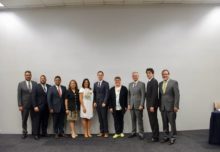There are warnings of economic stagnation of the Colon Free Zone’s main trading partners, such as Puerto Rico and Colombia. This, in addition to the possible delay in the commercial recovery of the sector by an additional few years, forces businessmen and authorities to take new measures in order to prevent the economic slowdown.
The Ministry of Trade and Industries (MICI), who chair the Board of Directors of the CFZ, revealed some short term measures: the regulation of electronic commerce operations; a change in image and logo of the complex (whose tender is in final stage); and redesigning the web site.
During the swearing-in of the new Board of Directors of the Association of Users (AU) of the CFZ, the Deputy Minister of Foreign Trade, Néstor González, pointed out that “it is important to remain at the forefront in terms of service, quality and efficiency, looking to optimise the investment of the users and the satisfaction of customers.”
Other measures considered were the implementation of a pilot plan to identify new markets; the adoption of best practices for business roundtables to generate transactions; develop user surveys to identify and facilitate analysis of needs; and support and promote the users’ business directory.
“Depending on the growth projection of these economies (Puerto Rico, Colombia, Venezuela or the Dominican Republic) and world trade, one could assume that in the short term, commercial activity should be not very different from what we see today,” said economist Felipe Chapman.
The commercial activity of the CFZ in 2016 was of $19.655 billion, 9.6 % less than the year 2015 and 33.6 % for below than the year 2012, when the complex entered a recession.
The International Monetary Fund (IMF) projects that the economies of Venezuela and Puerto Rico, the main destination of the exports of the complex thanks to the shipment of pharmaceutical products from Pfizer, will have a negative growth until 2022.
Multinational Push
According to the MICI, the commercial activity of the CFZ was of $10.107 billion in the first semester of this year, increasing by 8.2 % in comparison to 2016. The exports improved by 10.3 % and the imports 5.7 %.
The regional distribution of multinationals like Huawei, Hewlett-Packard, Under Armour or Pfizer has promoted this improvement. The management of the CFZ has recognised that the local businessman continues to suffer from the partial loss of the markets of Colombia and Venezuela.
The appreciation of the dollar must be added to these external factors, which makes the product more expensive once re-exported from Panama.
An internal element that obstructs the outlook to improve commerce, according to Usha Mayani, president of the commercial union of the CFZ, is the credit decrease that the users receive. In accordance with an Indesa analysis, this line diminished 10.1 % between 2012 and 2017.
Mayani, who was re-elected at the head of the AU for the period 2017-2018, indicates that one of the challenges of this new management will be to speak with the Panama Banking Association to figure out how to solve this situation.
“If trade decreases, so does credit, it’s true. But you also have to sit down and talk. When there is more financing, markets also rise. We must find a balance,” she said. The businesswoman noted that the association will hire the economist Rubén Lachman to develop a study on the role of CFZ in the Panamanian logistic cluster, and thus develop internal strategies to strengthen and rebound the commercial activity of the area.
Read original article here:
http://impresa.prensa.com/economia/Plantean-mejoras-ZLC_0_4813018750.html


